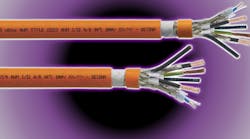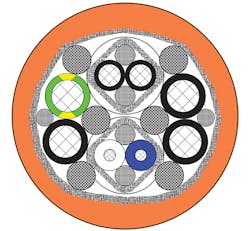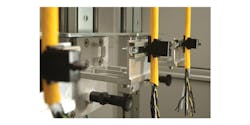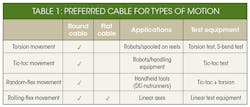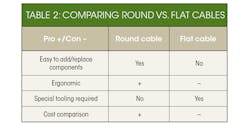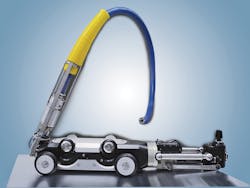Download this article in PDF format.
When designing an electronic system, cables are oftentimes the last component specified in by engineers. However, when the ideal cable system is expected to last the life of the equipment, it is important to develop a system of cables that are reliable in terms of their durability and ability to maintain proper signal integrity.
Unplanned downtime is unacceptable, in any industry or application. Therefore, cable systems represent the “lifeline” of modern machinery. In today’s heavily automated technology, moving applications pose many challenges to design engineers, who have to decide what form of a cable is the best fit—round or flat. Presented here are a few criteria to consider when making that choice.
Application
Depending on the market and application of intended use, round and flat cables each excel in particular settings. Round cables have long been the industry standard, and are used in most industrial applications from automated and general types of manufacturing to renewable energy.
Flat cables, while currently a niche solution, can offer a great solution for supplying power and data to machines within the medical, semiconductor, and civil-aircraft markets, among others. Flat or festoon cables are also highly sought after in the overhead crane market for companies that do not want to wind cables around spools.
Performance Criteria
Electrical Performance
- Electromagnetic interference (EMI): This includes both internal and external sources. Internal EMI protection varies and depends heavily on the cable's construction. Standard (unpaired) flat cables do not perform well as data cables. If designers run individual shielded pairs in a flat cable, it will provide crosstalk and coupling protection pair to pair.
It is very difficult to place an overall shield on a flat cable, as the shielding material tends to become round—it will not hold a flat format. This makes external EMI protection of flat cables very difficult and not readily available, because this natural shielding tendency provides better protection against external EMI for round cables.
- Crosstalk: This is the uncontrolled coupling of signals between two transmission circuits. Similar to EMI protection, using varied pair lay lengths within either a flat or round cable enhances protection against crosstalk.
- Attenuation: This ultimately determines the maximum length of a signal cable and conductor resistance, which impacts voltage drop on a power component. In most cases, attenuation tends to be worse when using a flat cable. Higher-quality insulation is used and proper placement of the ground can improve attenuation, resulting in flat construction. Some very-high-performance (low crosstalk and attenuated) flat cables are produced for certain industries.
One of the reasons power and signals are able to combine into a single cable is due to shielding. For example, the HELUKABEL TOPSERV Hybrid’s shielding protects it from EMI.
Mechanical Stress
The four main types of mechanical stress placed on cables are rolling flex, torsion, tic-toc, and S-bend. Round cables can withstand all of them due to their natural ability to move in multiple axes at once. In certain applications, round cables are able to withstand 30 million flexing cycles before they need to be replaced. Flat cables are best suited for rolling flex, because this movement is in one linear axis.
Rigorous testing ensures cables won’t fail in torsion applications.
Movements that require multiple axes such as torsion can cause the flat cable to bind or only twist to a certain point. Under torsional loads, the cable gets twisted and spooled over a certain length. Thus, every component must be integrated at the right twist and position, and be wrapped or embedded with a PTFE-tape (Teflon), to minimize the friction forces during torsion.
Table 1 summarizes the types of motion and the preferred cable type for each.
Environmental Stress
Cables are exposed to many environmental stressors that can cause cable to degrade over time if the proper materials are not used during the cable’s manufacturing. Some of these stressors include UV, oil, radiation, abrasion, high or low temperature, and friction. Knowing these factors in advance will strongly influence the selection of material properties (polyimide/foamed polyethylene, etc.) for conductor isolation and cable jacket materials (polyurethane).
Most PVCs or PTFEs used in round cables can be created to withstand many of these environmental stressors while maintaining their flexibility. Flat cables that are extruded with silicone will be able to withstand high temperatures. However, silicone is a softer material and doesn’t provide much abrasion and friction resistance, which could expose the inner conductors to potential failures.
Cable Design and Production
Round cables are designed to maximize space within the smallest cross-sectional area required. This allows round cables to fit in most panel or machine openings that otherwise might be a problem for a flat cable with an elongated cross-section—i.e., square peg, round hole. Furthermore, flat cables need to be weighed and balanced precisely to make sure movement is uniform. This is only required for round cables when they are installed in a cable track. Round cables only require fillers and tapes to ensure concentricity.
The weight and softness of a cable’s design is to optimize ergonomic performance for the end user, especially when the application is a handheld device (Table 2).
Finally, special tooling is required to encapsulate all flat-cable components into a single cable. Cable-manufacturing equipment is standardized to produce round cables, so the additional tooling turns into an extra manufacturing cost for customers.
Application-Specific Stress
Advanced applications in today’s industrialized society require cables to manage not just one type of stress at a time, but often multiple types. Some examples include:
- Abrasion and cut resistance: Because the cable system is spooled on reels and pulled over concrete and sharp edges, the outer jacket material needs the right shore-hardness for these parameters (polyurethanes have a good track record).
- Low elongation at high tensile load: This is achieved by a double-wall extrusion process, in combination with an aramid-braid (Kevlar/Vectran) in between to take mechanical stress off of the inner components. This construction type minimizes the tensile load placed on the inner conductors, which reduces fatigue and early cable failure.
Using a strength member in cable constructions reduces the reliance on the copper, thereby reducing the total amount of copper used and ultimately cutting down on cable size, weight, and cost. Such types of constructions might not be possible with flat cables that rely on silicones and PTFEs to encase multiple conductor components.
Jacketing is a serious application consideration. This round sewer cable in a pipeline robot must resist abrasion, UV, oil hydrolysis, and even microbial attacks.
In summary, many options are available when it comes time to design a cable system. Engineers should use a design funnel or checklist to narrow down the options in order to develop the solution that best meets an application’s electrical and mechanical requirements. Using this approach will ensure the cable design—round or flat—is optimal and gives all parties confidence that the cable system is durable and reliable.
